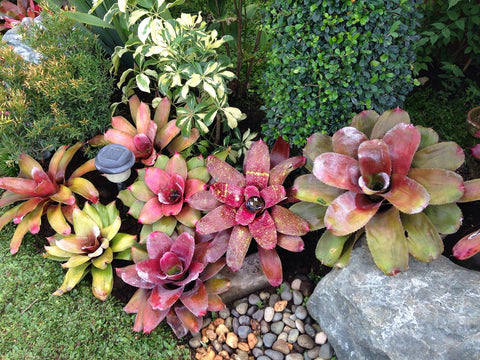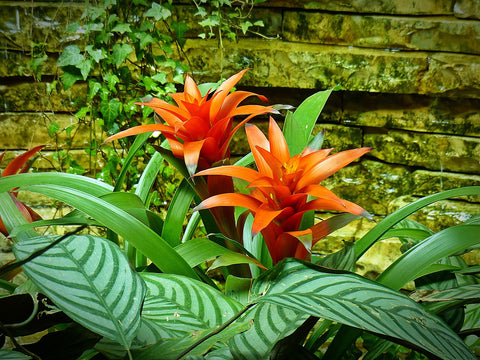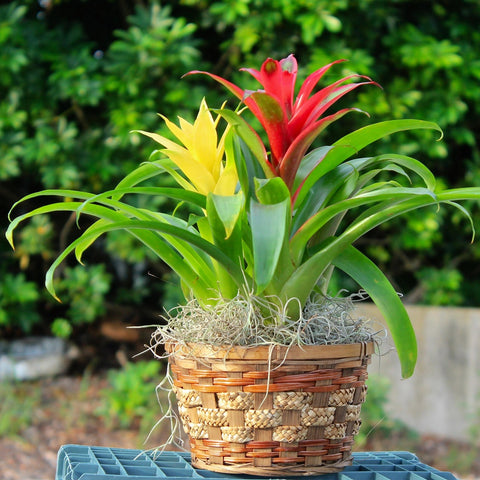Your Cart is Empty
Bromeliads are stunning tropical plants that can effortlessly transform any space into a lush, exotic paradise. With their vibrant foliage and unique rosette shape, these plants make for the perfect addition to your indoor or outdoor garden. Whether you're a seasoned plant enthusiast or just starting your journey with greenery, caring for bromeliads can be a rewarding and enjoyable experience. In this guide, we will walk you through the essentials of bromeliad care to help you keep these beautiful plants thriving in your home.
Before we dive into the care tips, it's essential to know a bit about these fascinating plants. Bromeliads belong to the Bromeliaceae family, which consists of over 3,000 different species. They originate from the tropical and subtropical regions of the Americas, from the southern United States to Argentina. While there's considerable diversity among bromeliads, they share some common characteristics:
Bromeliads often have a central rosette of leaves that form a cup or vase-like structure. This rosette collects water and nutrients, making them adaptable to various environments.
Bromeliad flowers are typically vibrant and long-lasting, adding a burst of color to your space.
Some bromeliads are epiphytic, which means they grow on other surfaces, like trees, while others are terrestrial, growing in soil.
Now that we've introduced these intriguing plants let's delve into how to care for bromeliads.
Bromeliads are relatively adaptable when it comes to lighting, but getting the right balance is crucial for their health and growth. Here's what you need to know:
Indirect light: Most bromeliads prefer bright, indirect light. Place them near a window with sheer curtains or in a spot with filtered sunlight.
Avoid direct sunlight: While some bromeliads can tolerate brief periods of direct sunlight, prolonged exposure can scorch their leaves. Protect them from harsh afternoon sun.
Low-light varieties: Some species, like Guzmania and Neoregalia, can tolerate lower light conditions, making them suitable for homes with limited natural light.

Bromeliads have unique watering needs due to their water-holding rosettes. Here's how to provide the right amount of moisture:
Water in the cup: Fill the central cup formed by the leaves with water. Change the water every one to two weeks to prevent stagnation.
Soil moisture: If your bromeliad is potted in soil, water the soil sparingly. Allow the top inch of soil to dry out before watering again. Always water the soil, not the rosette.
Avoid overwatering: Bromeliads are susceptible to root rot, so it's crucial not to let them sit in standing water. Ensure good drainage in your pots.
Bromeliads thrive in warm and humid environments. Here's how to create the right conditions for them:
Temperature: Keep your bromeliads in a room with temperatures between 60°F and 80°F (15°C to 27°C). Avoid exposing them to cold drafts.
Humidity: If you live in a dry climate, increase humidity by misting your bromeliads regularly or using a humidity tray. This mimics their natural tropical habitat.
Bromeliads are relatively low-maintenance when it comes to fertilizing. Here's what you need to know:
Use a balanced, water-soluble fertilizer: Feed your bromeliad every two to three months during the growing season (spring and summer) with a diluted, balanced fertilizer (e.g., 20-20-20).
Apply fertilizer to the soil, not the rosette: Pour the diluted fertilizer onto the soil around the base of the plant, avoiding contact with the leaves.
Bromeliads don't require frequent repotting. Repot when the plant becomes too crowded or outgrows its container, typically every 2-3 years. Use a well-draining potting mix, and ensure the new pot is only slightly larger than the old one.
To keep your bromeliad looking its best, remove dead or discolored leaves and spent flower spikes. Use clean, sharp scissors or pruning shears to do this.
Bromeliads can indeed be grown in pots, and the choice of potting mix is crucial for their well-being. Bromeliads are typically epiphytic in their natural habitat, meaning they grow on other surfaces like trees, and they don't rely on soil for nutrients. Instead, they obtain nutrients through their central rosette where water and debris collect.
If you decide to grow bromeliads in pots, it's important to use a well-draining potting mix that mimics their natural environment. A suitable potting mix for bromeliads typically consists of a combination of the following:
These materials provide a loose, airy structure in the soil mix, allowing for good drainage. Coconut coir is a sustainable alternative to peat moss.
These lightweight, porous additives improve drainage and aeration in the soil mix.
These components help retain some moisture while still allowing excess water to drain away.
Sometimes used to line the bottom of the pot to help retain moisture.
When potting your bromeliad, make sure to choose a pot with good drainage holes to prevent water from pooling at the roots. Fill the pot with the well-draining potting mix and plant your bromeliad, ensuring that the base of the plant is at the same level as it was in its previous container.
Remember, while the potting mix is important, bromeliads primarily derive their nutrients from the water they collect in their central rosette. Water the soil moderately, allowing the top inch to dry out before watering again. Be cautious not to water the rosette excessively, as this can lead to rot.

Bromeliads are relatively pest and disease-resistant, but like all plants, they can encounter issues. Keep an eye out for common problems like mealybugs, aphids, and scale insects. Treat infestations promptly with insecticidal soap or neem oil.
Bromeliads can be vulnerable to fungal diseases, and one of the most concerning and fatal fungal diseases that affect them is "crown rot." Here's more information on this and other fungal diseases, along with prevention and treatment measures:
Crown rot is a severe fungal disease that targets the central rosette of the bromeliad. It often appears as a softening and browning of the center, which can ultimately lead to the death of the plant.
Leaf spot fungi cause small, dark spots on the leaves of bromeliads. While not typically fatal on their own, severe infections can weaken the plant's overall health.
Root rot affects the roots of the bromeliad and can lead to the plant's decline. It's often caused by overly wet conditions and poor drainage.
Preventing fungal diseases is key to keeping your bromeliads healthy:
Proper Watering: Avoid overwatering, especially in the central rosette. Water the soil, not the rosette, and allow the top inch of soil to dry out before watering again.
Good Drainage: Ensure that the pot has proper drainage holes, and use a well-draining potting mix to prevent water from accumulating around the roots.
Air Circulation: Adequate airflow around the plant helps to reduce humidity around the leaves, making it less conducive for fungal growth.
Isolation: Quarantine new bromeliads for a few weeks before introducing them to your collection to prevent the spread of diseases.
If you suspect your bromeliad has a fungal disease, take action promptly:
Isolation: Remove the infected bromeliad from healthy ones to prevent the spread of the disease.
Pruning: Trim away infected leaves and affected areas, making clean cuts with sterile pruning tools. Dispose of the removed plant material properly.
Fungicides: In severe cases, consider using a fungicide that is safe for bromeliads. Follow the instructions on the product label carefully.
Improve Conditions: Ensure the plant's growing conditions are optimal, including proper watering, good drainage, and ventilation.
Repotting: If root rot is suspected, carefully remove the plant from its pot, trim away affected roots, and repot it in fresh, well-draining soil.
Remember that prevention is often the best defense against fungal diseases in bromeliads. Maintaining a healthy and well-cared-for plant is the most effective way to avoid these issues. Regularly inspect your bromeliads for signs of disease and act swiftly if you detect any problems to increase the chances of saving your beloved plant.
When treating fungal diseases like root rot and crown rot in bromeliads, it's essential to choose a fungicide that is both effective against the specific fungi causing the disease and safe for use on these plants. Here are a few fungicides that are commonly used to combat these issues:
Copper-based fungicides like copper sulfate or copper hydroxide are often effective against a wide range of fungal pathogens, including those causing leaf spot. Follow the product label instructions for proper dilution and application.
Thiophanate-methyl is a systemic fungicide that can be used to treat fungal diseases in bromeliads. It is effective against various fungi, including those responsible for root and crown rot. Follow the label instructions carefully.
Mancozeb is a broad-spectrum fungicide effective against many fungal diseases. Products like Dithane or Mancozeb-based fungicides can be used to treat root rot and crown rot. Always follow the manufacturer's instructions for application and safety.
Phosphorous acid-based fungicides can be effective against some fungal diseases, including Phytophthora spp., which can cause crown rot. These products can be applied as a foliar spray or soil drench.
Some gardeners prefer using biological control methods, such as Trichoderma-based products. Trichoderma is a beneficial fungus that can help suppress harmful root pathogens. These products are often considered safer for the environment.
In many cases where bromeliads suffer from root rot or crown rot, the soil in which these ailing bromeliads are planted is often depleted of essential soil microbes, with a notable absence of Trichoderma. The depletion of these beneficial microbes can occur due to various factors, including poor drainage, excessive use of chemical fungicides, soil compaction, overfertilization, soil erosion, elevated soil temperatures, and soil pollution from heavy metals, pesticides, and industrial pollutants. Therefore, maintaining optimal soil health, coupled with integrated pest management practices, is paramount for achieving success in growing healthy bromeliads.
Caring for bromeliads can be a fulfilling experience, offering you a glimpse into the lush world of tropical flora right in your home. With the right lighting, watering, temperature, and a bit of attention to detail, you can enjoy the beauty of bromeliads for years to come. So, go ahead and bring a touch of the tropics into your living space with these stunning and exotic plants!

Comments will be approved before showing up.
